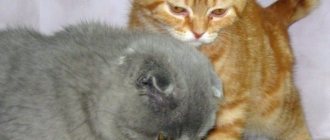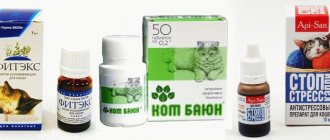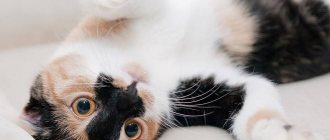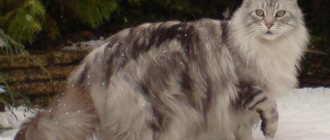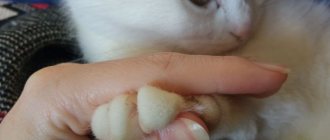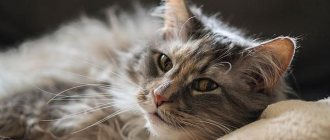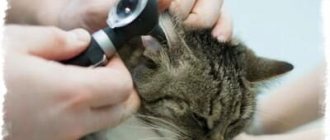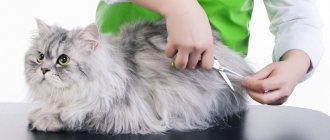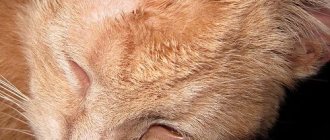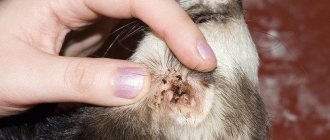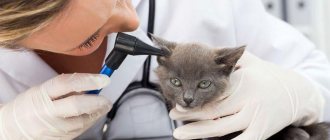Crossing Scottish cats to continue a high-quality breeding line should only take place under supervision and according to the rules approved by international felinological clubs.
In this regard, inexperienced owners have questions about what needs to be done to ensure that their pet has healthy offspring. Let's learn how to properly organize mating of Scottish Fold cats at home.
Can a fold-eared cat be crossed with a fold-eared cat?
Many owners of the Scottish Fold breed are interested in the question of who can breed a fold-eared pet with, and what kind of offspring is expected from this union. The answer to this question is ambiguous and depends on the purpose of mating.
Who can a Scottish Fold cat mate with?
The Scottish Fold cat can mate with any member of the cat family, except for males of its own species, if the pet is not going to participate in various exhibitions.
The Scottish Fold cat can mate with any member of the cat family.
It is noteworthy that these animals received lop ears during selection due to a mutation, which resulted in the formation of an anomaly of the ear cartilage, which is unable to hold the ears in an upright position.
Appearance of the breed
Scotland is recognized as the homeland of the animals, but mass breeding and selection began in the United States of America.
Scotland is recognized as the homeland of cats.
Mass breeding began in the USA.
Cats have a strong build.
The Scottish Fold breed is distinguished by its strong build, “plush” thick coat and high level of immunity. There is no specific characteristic color inherent in this particular breed. Individuals of this breed come in a variety of colors, but the most common is a grayish-gray tint.
Standards
For the Scottish Fold, CFA standards have been developed, according to which a cat with a medium or long tail, proportional to the body and narrowed or thickened towards the end, is suitable for exhibition.
- The head should be round, with a wide nose, expressive round and wide-set eyes.
- Rounded mustache pads, clearly defined and strong jaws and chin.
Cats have expressive eyes.
Rules for mating
To preserve the gene and obtain healthy offspring, special rules should be followed when mating females.
Puberty in females occurs around the eighth month of life. A cat will be ready for mating no earlier than one and a half or two years, depending on the individual characteristics of the animal’s body. Mating during the first heat is strictly prohibited due to the unpreparedness of the young female’s body.
Puberty in females occurs in the eighth month of life.
It is recommended to begin this process during the second, or even third, heat cycle. The third and fourth days of estrus are considered favorable. Before the event, the cat must have all the necessary vaccinations and deworming. The first mating should occur with a strong and experienced male.
Why you can’t cross a fold-eared cat with a fold-eared cat
To maintain breed standards, it is recommended to cross with a cat of the Scottish Straight breed - Scottish Straight.
Cat of the Scottish Straight breed.
It is prohibited to crossbreed with representatives of the same species as a cat due to the fact that the characteristic gene will lead to the birth of non-viable offspring.
Complications during pregnancy
Pregnancy will be complicated by miscarriage or the born kittens will have abnormalities of the musculoskeletal system.
The choice of male will depend on the similarity of coat color to obtain the most even color of the offspring and the same eye color. It is noteworthy that the female must remain in the male’s territory for two or three days, necessary for closer acquaintance and mating itself. A litter may have kittens with floppy ears and kittens with straight ears.
Kittens can be born with either straight ears or fold ears.
With whom is it allowed to cross a fold cat?
Crossbreeding with British Shorthair males is allowed in order to recruit a new set of gene pool.
British shorthair cat.
The offspring from several such crosses are subsequently mated with a Briton and the British Fold or kittens with half-dropped ears are obtained.
Features of pregnancy in fold-eared cats
The course of pregnancy in lop-eared females differs from other representatives of the cat family.
Due to the calm nature of this species, there are no mood swings, bursts of aggression, or isolation. The mother carries the kittens for approximately nine weeks. At the end of the mating, the animal calms down, becomes affectionate, and willingly makes contact with members of the household.
Pregnancy can only be determined after two or three weeks. The nipples change color, swelling and a more pink tint are observed. However, these signs are characteristic only of young animals; in older cats - older than three years of age - such signs may not appear.
Pregnancy can be determined after two to three weeks.
First half
The first half of pregnancy is characterized by increased appetite.
At this stage, fish feeding should be stopped to avoid the destruction of B vitamins, as they contribute to the normal development of embryos. It is necessary to increase the amount of food containing calcium: dairy and lactic acid products in the form of cottage cheese, milk, sour cream, kefir, yogurt.
Cottage cheese will be useful for a cat in the first half of pregnancy.
Second half
The second half passes calmly and only further growth of the abdomen and an increase in overall weight are observed.
In the second half of pregnancy, growth of the abdomen is observed.
It will be possible to determine the number of fold-eared and straight-eared kittens only after twenty-two days. At the first stage, the entire brood looks exactly the same, and they cannot be distinguished.
Third week
By the end of the third week, the cartilage begins to mature and strengthen, and everything falls into place. In Fold kittens, the ears curl even more and bend towards the head, while in Straights they gradually straighten.
By the end of the third week, kittens' cartilage begins to strengthen.
Video about the Scottish Fold cat breed
Description
Fluffy wool.
Beady eyes.
Friendly character.
Everyone's favorite.
Straight back.
Curly head.
Their distinctive feature is their soft, wavy fur, which makes them look like plush stuffed animals.
- The dogs have a strong, rectangular body with a wide, straight back. The height of the animals does not exceed thirty centimeters, and they weigh from three to six kilograms.
- The paws are short and thick with round pads.
- The tail is of medium length, covered with fluffy curly hair.
- Due to the long hair, the doggies' head looks round, but in fact, it is slightly elongated with a flat forehead with a smooth transition line to the nose;
- The ears are of medium length, hanging down to the middle of the muzzle. Expressive round eyes are black.
- Dogs' coat is soft, fluffy and curly, with a dense, thick undercoat.
- According to the standard, the color of dogs of this breed can only be snow-white. Colored spots on the body and beige or cream color of the coat in adults are considered faults.
Bichon babies are born with yellowish or reddish spots on their snow-white coat, but as they grow older, the color of the animal becomes uniform.
Spots on the body of puppies can persist until they are one year old.
Always in moving.
Loves walks.
Loves to play.
- A perky and cheerful pet loves to be the center of attention, and there is no greater pleasure for him than playing together with his beloved owner.
- Dogs of this breed are very smart and observant. They subtly sense the mood of the people around them. If the dog notices that one of the family members is feeling sad, the dog will put on a real circus performance for him, trying to cheer him up with funny tricks and involve him in a fun game. And looking at the amusing antics of the pet, no one will be able to resist smiling and resist his unique charm.
- These animals express all their feelings and emotions with the help of a loud, booming bark. The owner needs to prepare for the fact that the pet will express its opinion on any occasion with a ringing yelp.
- Small curly dogs get along well with any pet and are able to make friends with both another dog and a cat. The Bichon Frize has absolutely no aggression or feelings of jealousy, and they perceive the other pet as a companion for fun games and pranks, and not as a rival or competitor.
- When getting a dog of this breed, you should take into account that they need constant communication and attention from the owner and cannot stand loneliness. You can’t leave your dog alone for a long time, because a bored pet is capable of minor mischief. Therefore, when returning home after a long absence, owners should not be surprised if their curly pet pulls the bedspread off the bed, chews on the owner’s slippers, or guts the sofa cushions. Moreover, the dog will not feel remorse for his tricks. A pet caught at the scene of a crime will take on an innocent and even offended look, thanks to which the cunning dog will always avoid fair punishment.
- It will not be possible to make a guard and a defender. These animals are quite cowardly and, when they see a stranger, they try to hide in a secluded place. The most that curly-haired dogs can do is bark at a stranger while remaining at a safe distance.
Easy to learn simple commands.
Loves to perform various tricks.
Intelligent and quick-witted, French lap dogs are easy to train. A curly-haired pet will not only quickly remember its name, but will also learn to perform simple commands and funny tricks if you work with the dog daily.
Good results in training can be achieved by turning classes into a fun and exciting game that will bring pleasure to both the dog and the owner.
It is very important, in case of successful execution of a command, to encourage your pet by treating him with a treat, petting him or simply praising him for his intelligence.
Why can't you cross two fold-eared animals?
The occurrence of lop ears in cats is associated with a random mutation in one cat on a farm in Scotland back in 1961. The white fold cat was registered and became the first fold cat of this breed. After this incident, scientists began working on developing a new breed of cats with folded or lying ears.
Over time, modern geneticists have come to the conclusion that the gene that gives cats lop ears is dominant. This suggests that in the process of passing genes from parents to children, one gene responsible for the shape of the ears must be lop-eared. In this case, the kitten will have flat ears. But in the case when both parents have both genes responsible for the shape of the ears, the kitten will be born homozygous for lop ears (that is, with the same genes in a pair).
What are the difficulties?
It happens that young Scots do not quite understand how the process should work. The cat rolls the cat on the floor, positioning itself on different sides of the body. In this case, the owners must help the pets take the correct position. It happens that a cat is afraid of a new place or a cat, so the owner should be attentive and affectionate, and not put pressure on the pet. In a stressful situation, a cat may refuse to mate altogether. Also, partners may become too attached to each other and no longer accept other animals. If one of the partners is already bred, but the previous crossing was incorrect or associated with negative emotions, the partner develops fear due to the shade of the coat or eyes. Therefore, you should find another pair for such pets.
Fold cat and cat: is it possible to bring them together?
This is a big disadvantage in its further development - there is a very high risk of problems with bone development.
Thus, the lop ear gene can lead to a homozygous development of the kitten. This property is the main reason why scientists do not recommend crossing lop-eared individuals with each other. Only the connection between a straight-eared and a fold-eared kitten will allow you to produce healthy fold-eared kittens in a litter (50% of the litter has this gene).
That is, the answer to the question of why it is impossible to bring two lop-eared animals together is the following theory: all owners of lop-eared ears contain this gene, which is responsible for the bending of the ears. And if you cross two lop-eared individuals, then kittens with numerous diseases and problems will be born.
Today there are many unscrupulous breeders who, despite all the warnings, specifically breed two fold-eared kittens, since fold-eared kittens are much more expensive than straight-eared ones. The problem is that kittens from such a litter can be born seemingly healthy, and after one or two years the disease will make itself known. People who commit such mating are outright sadists!
Stories from breeders of fold cats
The other day I met a woman who firmly stated that she had been mating a cat and a cat with fold ears for 8 years. The terrible thing is that she knows about the consequences of such a mating and she is absolutely not ashamed of it! Leaving it to chance, she stated that she had no problem with it. I decided to check.
I took the kitten from this woman and went to the veterinary clinic for diagnostics. A routine X-ray revealed serious genetic mutations. The kitten's bones have fused incorrectly! The structure of the ridge mutated, the tail did not bend at all due to its hardness. The veterinarian concluded that this kitten would live no more than two to three years. Having shown the veterinarian’s report to the kitten’s owner, I was surprised by her behavior. She snatched the poor animal, declared that all this was not true and closed the door.
Be carefull! Pay attention to reviews and recommendations when choosing a fold-eared kitten. You can also have your kitten examined by a veterinarian.
But it’s not just about the correct mating to produce healthy lop-eared offspring. There are cases when genetic mutations can occur under other circumstances, for example, “it didn’t grow together.” This is nature!
The main goal of professionals is to produce healthy offspring with minimal risk of genetic mutations.
How to choose a healthy fold-eared kitten?
First of all, pay attention to the recommendations of nurseries. But keep in mind that it is impossible to predict genetic diseases in purebred cats! After all, all mammals are born healthy, and what awaits them next is unknown. Love your pets and they will thank you back!
Formal Details
Where to look for a good cat? Among acquaintances. According to advertisements on the Internet. At a nursery in your city. Through the club.
Before mating, you must sign an agreement that stipulates all the conditions, including the period for which you are giving the cat away, a guarantee of pregnancy (if it does not occur the first time, the groom’s owners should be prepared for another 2-3 free matings). The contract also states the price you pay for mating, or payment by the kitten.
If you are looking for a mate based on an advertisement, you should know that there are cases of fraud when the advertisement for a cat contains one information, as if the cat has titles and certificates, and then it turns out that this is not true and he is not allowed to breed at all. It happens that the photos in advertisements are fake. You can learn more about this topic from the video. There is only one piece of advice on how to avoid fraud: check all documents, do not take anyone’s word for it.
Why can't you breed two fold-eared cats?
It has long been known that cats create coziness in the house. They also lift the spirits, heal, pacify with affectionate purring... It is not surprising that these graceful beauties and beauties take first place among pets. And if a couple of decades ago the most common species was the “domestic tabby cat,” today the number of their breeds has exceeded seventy.
One of them is the Scottish Fold cat or Scottish Fold.
Fold cats are rapidly gaining popularity among breeders. They are winning more and more hearts thanks not only to their large, expressive eyes and ears touchingly pressed to their heads, but also to their character - calm, balanced, and at the same time unobtrusive. That is why Scottish Folds are quite possible and even recommended to be owned in families where small children are growing up.
But in addition to a lot of advantages, this breed also has one unpleasant feature that any breeder planning to get offspring will definitely encounter.
Why can't you breed two fold-eared cats? Not everything is so smooth.
Those very flattened ears that won many hearts were obtained as a result of a random mutation. They were considered a good solution and breeding of fold-eared kittens was put on the conveyor belt. But soon they had to stop reproduction, and then completely ban it - some of the offspring were born with problems of the musculoskeletal system.
After the ban in Europe, American scientists took up the task, and it was they who found out that the gene for lop ears is dominant and has a negative effect. Kittens from parents with such genes were born with fused vertebrae, a fixed tail, malocclusions, curvature of paws and other similar disorders. Moreover, these anomalies could appear not only in newborns, but also many months later. The kittens refused to eat, could not cope with chewing food, had problems with digestion, often could not move independently, and in some cases died.
Do not cross dominants
It turned out to be logical and lay on the surface - to prevent the crossing of two individuals with dominant genes. In the case of lop ears, the recessive gene is straight ears, and the offspring from such parents were healthy without significant defects. At the same time, half of the kittens in the litter turned out to be fold-eared.
This method is still effective, and anyone who plans to start breeding fold cats should adhere to it. Because the risk of getting offspring with congenital anomalies is not just great - it is one hundred percent. Very often, such kittens are not viable, and sometimes the babies have to be forcibly euthanized, because with such deviations they simply cannot lead a normal life.
These are amazing creatures, very affectionate and responsive. They adapt well to a new place, quickly become attached to people, are friendly with other animals and have no problems with toilet training. You just need to remember about the rules of their breeding, and Scottish Folds will become wonderful pets and faithful companions for many years.
What is the owner of the male responsible for?
- If animals have difficulties, they need help.
- Some animals can show aggression, therefore, at the slightest problem, it is better to postpone all mating actions. Maybe after a while the cats will get used to each other.
- Upon arrival at your destination, it is best to keep the cat in its portable vehicle for a while. Let her get used to it, sniff it, rest and gain strength.
- If animals are too aggressive, it is better to place them in enclosures so that they can get used to each other.
They love to show off their joy and amuse their owner.
People who are lucky enough to become the owners of these amazing creatures claim that they have a lot of advantages, without having any significant disadvantages.
- Despite their fluffy, curly coat, the dogs hardly shed, and their fur does not have an unpleasant odor.
- The lapdogs have a cheerful, friendly and peaceful character.
- Dogs are easy to train, and their education does not require much effort.
- Animals are very careful when it comes to toileting, and they are easy to train to a tray or a special diaper.
- These are ideal pets for children as they are playful, active and non-aggressive.
Cons of the breed
When sad and alone, a Bichon can whine for a long time and is even capable of minor mischief, for example, tearing the owner’s slippers or tearing a pillow.
- You will have to devote a lot of time to caring for the dog's fur.
- They cannot stand loneliness and bark and whine in the absence of their owners.
- They are prone to allergies to certain products and detergents used to care for their snow-white coat.
Many Bichon Frize owners claim that their curly-haired pets know how to smile, and when carried away by a playful, cheerful game, they sometimes make sounds that vaguely resemble laughter.
Together with a positive, friendly curly dog, joy and good mood will forever settle in your home. The Bichon Frize is always ready to please its owners with its amusing and amusing antics, and you will never be bored with such a pet.
Is it possible to cross Scottish cats with Scottish cats?
Interbreed matings never produce purebred animals. But for some reason, quite a lot of people contact the editors of the Scottish cats website “Murkotiki” with the question of whether it is possible to cross Scottish cats with Scottish cats? Where does such a frequent question come from and does it have any real basis? Let's figure it out.
The idea that Scottish cats cannot be bred with each other has its origins in the topic of genetics.
The fact is that if you cross fold-eared cats with fold-eared cats, or vice versa - fold-eared cats with fold-eared cats, you will get sick offspring. It's all because of the fold (fold-eared) gene: in the scientific world it is designated Fd. It is dominant, that is, when paired with any other gene, it causes the ears to droop. But this gene not only causes the ears to droop, which occurs due to weakness of the cartilage, but also affects all joints and cartilage in a similar way, making her musculoskeletal system not entirely complete.
In some folds, this gene is visually manifested only on the ears - and the animal feels healthy. Some people develop terrible diseases that prevent them from leading a full life. Why does it happen that some, despite their lop ears, are healthy, while others are not?
On the one hand, this is the will of nature, which obeys only the theory of probability. Even with correct crossing, which will be discussed later, there is a risk of having sick offspring. But still this risk is low. On the other hand, there is a way to get sick offspring in almost 90% of cases. To do this, you need to cross two lop-eared individuals. Each of them is a carrier of the Fd gene.
Let me explain. In order for the offspring to receive a certain trait, it needs two genes - from the father and from the mother. If an individual has only one dominant gene for drooping ears - Fd, that is, from only one parent, and the other gene is the recessive gene fd (suppressed straight-eared gene), then such a kitten will most likely be healthy, but at the same time will receive droopy ears, because . the Fd gene is dominant over the fd gene. But at the same time, the fd gene restrains the Fd gene and prevents terrible diseases from developing.
If you cross two fold-eared cats, each of which has the Fd gene, there is a high probability that the kittens will receive the following combination: Fd + Fd = FdFd. Then they will not have the disease-restraining gene fd - and the animals will be born sick: lame, with deformed joints, experiencing pain with any movement. This is why it is impossible to cross two Scottish Fold cats.
But what then can be done to get healthy purebred Scots? There is an answer to this question. To obtain healthy offspring, it is necessary to cross a Scottish Fold cat and a straight-eared Scottish cat, or vice versa - a straight-eared Scottish cat and a Scottish Fold cat. Didn't you know that the Scottish breed includes as many as four varieties? These are the Scottish Fold (Scottish Fold Shorthair cat), Scottish Straight (Scottish Straight Shorthair cat), Highland Fold (Scottish Fold Semi-longhair cat) and Highland Straight (Scottish Straight-eared Semi-Longhair cat). Thus, you can cross like this: Scottish Fold + Scottish Straight, Scottish Fold + Highland Straight, Highland Fold + Highland Straight, Scottish Straight + Highland Fold.
You can breed a Scottish cat with a Scottish cat
There is one caveat. Sometimes folds develop ears over time. Sometimes this happens so quickly that an illiterate breeder does not have time to identify them as folds. Or the cats end up with new owners, and because of their straight ears, they think that they bought straight cats. As a result, they will breed their cats as straight cats, that is, with folds. But the lop-eared gene has not gone away: it simply did not appear visually. And then the offspring will come from two folds, that is, most likely, terminally ill. Therefore, before such matings, a cat about whom there are doubts (for example, his ears are smaller than usual or not erect enough) needs to undergo a genetic examination. Or sterilize it out of harm's way.
Now you understand where the fear arose that Scots should not be mated with Scots. Many, having never learned what is actually possible and what is not, begin to look for a representative of another breed for their cat and make a big mistake, because the kittens will already be hybrid, not purebred, with an unpredictable appearance and character. It will be very difficult to sell these. And there is no point in spoiling the Scottish breed, which has long managed well without interbreed matings?
Separately, many people ask whether it is possible to breed a straight-eared Scottish cat with a straight-eared cat? Can. But from such a pair only straight-eared kittens will be born, and they are cheaper than fold-eared ones.
Here's the situation. . straights are bred to folds, because in this case we will get heterozygotes for the lop-eared gene, i.e. the kittens will be normal (of course, if the parents do not carry any genetic abnormalities and are allowed for breeding). in the homozygous version, the lop-eared gene can lead to disastrous consequences (a homozygote for the lop-eared gene will result from a fold-fold mating). mating straight-straight does not make sense because there is no chance of giving birth to kittens with a breed-forming trait. Now about the fact that you don’t need exhibitions and about the “benefits” of childbirth. Childbirth in cats, like in humans, has little benefit for the mother’s body. Just imagine a cat for 2 months giving all its juices to the cultivation of several organisms. Closer to giving birth, it becomes difficult for a small cat to walk (a cat can double its weight during pregnancy - try doubling its weight in a couple of months... well, how? Is it easy to run?), i.e., the load on the skeleton may increase by 2 times. Further, during a multiple pregnancy in a cat, the kittens put pressure on the internal organs; it is not so easy for the cat to breathe at the end of pregnancy. well, the cat just can’t wash itself - well, it doesn’t reach because of its belly. Of course, this does not happen with all cats, because a cat can bear from one to eight (sometimes more) kittens. The birth itself also happens differently for all cats. some give birth easily, while others only have a cesarean section (there are many reasons, either a large kitten or simply a lack of labor). also with maternal instinct. Some cats are fine, but some simply refuse kittens right away and don’t understand what to do with them. both in the case of a caesarean section and in the case of a cat’s abandonment of kittens, their upbringing falls on your shoulders. this means that for the first 3-4 weeks after giving birth you will first have to sleep for an hour between feedings (it’s not the children’s fault that this happened and want to eat), and the kittens will also need to pee and poop (if the cat doesn’t do this). Again, I repeat, this doesn’t happen often, but how do you know how it will turn out for you? Now about the exhibitions. Apparently, you know little about the breed, and even then, in fact, you “heard something somewhere”….Scottish is not a simple breed, it won’t work out with anyone (unless, of course, you don’t care about kittens). you need to clearly know how to select a pair, regardless of whether you have a fold or a straight. and the club can help you choose a cat just for your cat. exhibitions are important because, for example, out of ignorance, you may simply not understand whether your cat can be knitted or whether it can be knitted by this fold-eared cat that was offered to you. maybe he carries disqualifying defects that are passed on to kittens and you put a cat under him... - you don’t agree well... Likewise, your cat may not be allowed for breeding due to some parameters.
straight-eared ones only with folds and knitting!
You can breed Scottish straight-eared dogs with Japanese short-legged dogs, and their offspring with the neighbor Tuzik!
You can’t if you don’t want to end up with freaks. and for what purpose is mating? If you had at least completed felinological courses, you would not be asking such stupid questions. Yes, even if you participated in exhibitions, communicated with serious breeders, you would not have such a question either. Giving birth will not improve your cat's health. So what is mating for? For profit?
folds are crossed with straight-eared ones, this is cat law)))) otherwise there may be problems with the offspring
straights are knitted with the British, folds are also knitted only with the British, straights with folds are not knitted
Folds cannot be combined with folds, only with straights.
Scottish Straight needs to be mixed with Scottish Fold, what’s so difficult? what do the British have to do with it?! This is a completely different breed!
I’m not lying to Lozinka that giving birth won’t improve a cat’s health. Although I have not completed the course, experienced breeders unanimously tell me that a cat must give birth at least once in its life. I know for sure that folds are not mated with folds - there is this gene for lop-earedness. But I see no reason why two Straights cannot be mated. It’s better to call the breeder from whom you took the kitten, or the club you’re a member of - they’ll tell you for sure. or search here: mauforum.ru
I strongly advise you to still get documents for the cat (the breeder should have kept the birth certificate or pedigree, you can buy it), complete felinological courses and, if you really want to, engage in breeding with intelligence and knowledge of the matter, and not just “I heard somewhere, that folds don’t go together with folds.” There are a lot of subtleties and peculiarities of inheritance in pedigree breeding; the breeding program is also not written out of the blue. There are many more reasons for kittens to be born deformed than just lop ears. Again, you probably don’t know why your cat was sold without documents - that is, you were probably told like “we just don’t want to bother,” but what really happened there (maybe an inherited growth along the white line? or something worse) - no one will say, that’s why pedigrees are needed - to know exactly what kind of children they will get and to minimize the chance of deformities. Childbirth, again, did not improve the health of any cat. Well, cats also have AIDS and other STDs. Among them, for example, feline viral peritonitis is a fatal, untreatable disease that guarantees a painful, slow death from sepsis. You probably won’t check your cat for the full range of viruses - it’s probably just as undocumented.
Childbirth among Scots
Let's look at when and how labor begins in a Scottish Fold cat. The first signs of labor in a cat are brownish vaginal discharge.
The behavior of a cat often changes before giving birth: the animal is looking for a place (nest) to give birth, screaming and making attempts, especially if the Scottish female gives birth to kittens for the first time. In such a situation, it is worth staying close to the cat, calming it down and caressing it, and if necessary, helping, delivering the cat’s birth. Kittens are born head first.
Newborn kittens weigh about 100 grams and are a bubble filled with light yellow liquid. After the kittens are born, the mother chews this bladder, releases the cub and licks it to cleanse the lungs. You can help her with this by suctioning the fluid from her nose with an enema while the female gives birth to other kittens.
Kittens come out at intervals that last about 20 minutes, however, the cat can independently increase the duration of labor and delay the appearance of the babies and carry them for another day if something does not suit her or frightens her. After the young mother has been able to give birth to a kitten, the afterbirth comes out.
A Scottish cat will give birth to approximately 2 to 4 kittens the first time, but in general they will give birth to 1 to 8 kittens.
Kittens open their eyes a week after birth. All Scottish kittens are born with straight ears, and only at 3 weeks of age should you pay attention to the ears; in folds, they begin to droop.
Basic rules for mating a Scottish Fold cat - expert advice
In general, all the subtleties cannot be described in the “answers” - that is why felinological courses are at least 10 lectures, because there is a lot of material, and all of it is important, there is nothing to throw out from there. I highly recommend visiting it if you really want to engage in breeding. And kittens without documents only lead to poverty; there is no way to prove the breed of a kitten except by pedigree, it’s just phenotypic, even if you know that it is from purebred parents.
only with folds
In general, every woman is advised to give birth. many gynecological diseases disappear or stop developing after a woman gives birth and breastfeeds. I don’t think that in terms of technology we are much different from cats. They have almost the same female diseases as we do.
Login to write a reply
How does the knitting process take place?
All actions take place in the territory of the male’s residence. Before breeding a Scottish Fold cat, it is contraindicated to wash it, as this will deprive it of the characteristic odor that attracts the male.
Most often, the entire process occurs without the help of the owners, but it happens that animals get lost, especially cats. In this case, they need to give time to rest, get used to it and sniff.
The male may show interest, sing songs to the female, and she, in turn, responds to his advances. If the female is not ready to mate, the male senses this and simply leaves. In this case, further actions will be ineffective; you need to wait for the next heat.
The following are the rules for mating Scottish cats:
- Age of the cat. You can take her to a male only during estrus and at the age of 1 year. Even though they reach puberty at 6-7 months, they are not yet ready to have offspring. Moreover, the animal is not yet fully formed, and this can lead to serious health problems.
- You cannot cross two Scottish Folds, or with a British male. This can lead to health problems for kittens.
- If you plan to use kittens for exhibitions, you need to take a responsible approach to choosing a partner, his pedigree, color and other characteristics.
- It is imperative to monitor the health of the animals; in case of any ailment, it is better to postpone the mating process.
If you follow all the rules, then mating a Scottish Fold cat will bring beautiful, healthy and strong offspring.
https://youtube.com/watch?v=AXQMS6_jcHs
Breeding work
Your charming pet is growing up, the time has come for the final choice - you have chosen to breed Scottish Folds.
But before breeding animals, you need to learn in detail about the Scottish Fold breed itself, about the features of their breeding.
